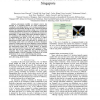Free Online Productivity Tools
i2Speak
i2Symbol
i2OCR
iTex2Img
iWeb2Print
iWeb2Shot
i2Type
iPdf2Split
iPdf2Merge
i2Bopomofo
i2Arabic
i2Style
i2Image
i2PDF
iLatex2Rtf
Sci2ools
RAM
2015
IEEE
2015
IEEE
Autonomous mobility on demand in SimMobility: Case study of the central business district in Singapore
—Autonomous mobility on demand (AMOD) has emerged as a promising solution for urban transportation. Compared to prevailing systems, AMOD promises sustainable, affordable personal mobility through the use of self-driving shared vehicles. Our ongoing research seeks to design AMOD systems that maximize the demand level that can be satisfactorily served with a reasonable fleet size. In this paper, we introduce an extension for SimMobility—a high-fidelity agent-based simulation platform— for simulating and evaluating models for AMOD systems. As a demonstration case study, we use this extension to explore the effect of different fleet sizes and stations locations for a station-based model (where cars self-return to stations) and a free-floating model (where cars self-park anywhere). Simulation results for evening peak hours in the Singapore Central Business District show that the free-floating model performed better than the station-based model with a “small number” of station...
| Added | 17 Apr 2016 |
| Updated | 17 Apr 2016 |
| Type | Journal |
| Year | 2015 |
| Where | RAM |
| Authors | Katarzyna Anna Marczuk, Harold Soh Soon Hong, Carlos Miguel Lima Azevedo, Muhammad Adnan, Scott Drew Pendleton, Emilio Frazzoli, Der-Horng Lee |
Comments (0)

